If you’re a seasoned guitarist or musician, you’re probably familiar with the 12 intervals (semitones) in western music. However, there’s a whole world of microtonal music that uses intervals smaller than a semitone. So what is a microtonal guitar exactly? A microtonal guitar is an instrument that has smaller distances between frets, extra frets, or adjustable frets which essentially allows you to play more notes between the original 12 pitches in western music.
Microtonal guitars have been around for a long time, but they’re not as common as standard guitars. One reason for this is that microtonal music is not as well-known or widely played as standard music. However, microtonal guitars are gaining popularity among musicians who want to explore new sounds and create music that is outside of the traditional Western tuning of twelve equal intervals per octave.
In this article we cover various topics related to the microtonal guitar, including genres it’s used in, the theory behind it, and its use in popular culture.

Related: What is a baritone guitar
Understanding Microtonal Guitars
If you are a guitar player looking to explore new sonic possibilities, you may have heard of microtonal guitars. Microtonal guitars are guitars that are designed to play notes that are not in the Western tuning system. In other words, they allow you to play notes that fall between the keys of a piano tuned in equal temperament.
What is an Adjustable Microtonal Guitar?
An adjustable microtonal guitar is a guitar that lets you move all the frets according to your tonal needs. They can be tuned to a variety of different tuning systems, such as just intonation or various historical tunings. This means that you can play notes that are not available on a traditional guitar. Microtonal guitars can be either acoustic or electric, and there are also versions with fixed frets that are not moveable.
How does an Adjustable Microtonal Guitar Work?
An adjustable microtonal guitar has a fretboard with movable frets that can be adjusted to play notes that are not in the traditional Western tuning. This allows you to play microtones, which are intervals smaller than a semitone and customize the guitar to your exact playing style.
Why Use a Microtonal Guitar?
Microtonal guitars offer guitar players a way to explore new tonal possibilities and expand musical horizons. They are especially useful for playing music that is not in the traditional Western tuning system, such as Middle Eastern or Indian music. Microtonal guitars can also be used to create unique and experimental sounds that’s different than what we’re used to hearing in traditional western music.

Related: What is a resonator guitar
Microtones in Different Musical Genres
Microtones have been used in various musical genres across the world. In Western music, music with microtonality has been used by composers such as Charles Ives, Olivier Messiaen, and Krzysztof Penderecki. Microtonal music in Western music is often used to create dissonant and atonal sounds, which can be used to create tension and drama in a musical composition.
In Eastern music, they play microtonal music as a fundamental part of their musical tradition. For example, Indian classical music uses microtones to create various ragas, which are melodic structures that are used to evoke different moods and emotions. Similarly, Turkish music uses microtones to create various maqams, which are melodic structures that are used to evoke different emotions.
In jazz, microtones are often used to create the “blue notes” that are characteristic of the genre. Blue notes are notes that are sung or played at a slightly lower pitch than the standard pitch, which gives them a “bluesy” sound. Microtonal music is also used in avant-garde jazz, where it is used to create dissonant and experimental sounds.
Microtonal guitars have become increasingly popular in recent years, and they are used by musicians in various musical genres. Microtonal guitars allow musicians to play microtones that are not possible on standard guitars, which gives them more flexibility in their playing. Microtonal guitars have been used in various musical genres, including rock, jazz, and experimental music.

Related: What is a rhythm guitar
Famous Microtonal Composers and Works
One of the most famous microtonal bands today is King Gizzard & the Lizard Wizard. Their “Flying Microtonal Banana” album, released in 2017, stands as a testament to the innovative potential of microtones in modern music. The band modified their guitars, adding extra frets to explore the subtle nuances of microtonal notes, resulting in a sound that’s both exotic and mesmerizing. Tracks like “Rattlesnake” and “Melting” showcase their fusion of psychedelic rock with the haunting tones of a microtonal guitar, creating a unique sonic experience.
What makes the King Gizzard “Flying Microtonal Banana” album truly exceptional is its ability to transport listeners into a new musical dimension. It demonstrates how the use of a microtonal guitar can expand the boundaries of music, using the spaces between traditional notes to craft compositions that are hypnotic and groundbreaking.
Another well-known artist, Harry Partch, was one of the first composers to experiment with microtonal music. He created his own tuning system, which he called “just intonation.” Partch’s music is characterized by its use of unconventional scales and tunings, which give it a distinctive sound.
Iannis Xenakis and Lou Harrison are two other composers who have used microtonal music in their work. Xenakis was known for his use of mathematical models in his compositions, while Harrison was interested in the music of other cultures and incorporated elements of Indonesian gamelan music into his work.
Microtonal Music Theory
Microtonal music theory is a fascinating and complex subject that deals with the use of microtones in music. Microtones are intervals smaller than a semitone and are used to create new and unique sounds that are not found in the traditional Western tuning system of twelve equal intervals per octave.
In microtonal music theory, notes are not restricted to the semitones found in the diatonic major scale. Instead, they can be any interval, including fractions of a semitone. This allows for the creation of new chords, scales, and harmonies that are not found in traditional Western music.
The concept of the octave is still used in microtonal music theory, but the way it is divided is different. In traditional Western music, the octave is divided into twelve equal semitones. In microtonal music theory, the octave can be divided into any number of intervals, depending on the desired sound.
Musical scales and temperaments are also different in microtonal music theory. The most common musical scale used in microtonal music theory is the just intonation scale, which is based on simple musical ratios. This scale is often used in traditional Middle Eastern and Indian music.
The concept of cents is also important in microtonal music theory. A cent is a unit of measurement used to describe the difference in pitch between two notes. There are 100 cents in a semitone, and microtonal music theory often uses intervals that are smaller than a semitone.
Accidentals and notation are also different in microtonal music theory. In traditional Western music, accidentals are used to indicate notes that are outside of the diatonic major scale. In microtonal music theory, accidentals are used to indicate notes that are outside of the equal temperament tuning system.
Microtonal Music in Popular Culture
Microtonal music has been gaining popularity in recent years and has found its way into various genres of music, including pop, rock, and classical. One example of a popular song that uses microtones is “Blackbird” by The Beatles. The guitar solo in the song features a descending line that includes microtones. Another example is “Bohemian Rhapsody” by Queen, which uses microtonal harmonies in the chorus.
Microtonal guitars have also become more popular in recent years. One of the pioneers of microtonal guitar is Walter Vogt, who created the first microtonal guitar in the 1970s. Vogt’s guitars feature movable frets that allow the player to play microtones. In addition to Vogt, other luthiers have also created microtonal guitars, including luthier Yuri Landman.
Microtonal music has also been featured in many festivals around the world. One example is the MicroFest, which is a festival dedicated to microtonal music. The festival features performances by microtonal musicians and workshops on microtonal music. Another festival that features microtonal music is the Huddersfield Contemporary Music Festival, which features contemporary classical music, including microtonal music.
Classical guitarists have also started to incorporate microtones into their playing. One example is the classical guitarist and composer Julian Carrillo, who developed a system of microtonal tuning for the guitar. Carrillo’s system, which he called “The Thirteenth Sound,” uses 96 notes per octave instead of the usual 12 notes.
In conclusion, microtonal music has become more prevalent in popular culture in recent years. From pop songs to classical guitar, microtones are being used to create new and unique sounds. With the continued development of microtonal musical instruments and tuning systems, it is likely that microtonality in music will continue to grow in popularity.
